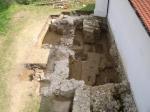Summary (English)
The curently Baroque, originally Gothic church of St. Laurent (crkva sv. Lovre) near the village of Crkvari is located on a prominent hill that was converted for defensive purposes in the Middle Ages: a deep ditch formed an earthen rampart that encircled a central elevation of a slightly rectangular shape (50×30 m) with rounded corners. The Gothic phase of the church, based on the profiling of the southern portal, was roughly dated to the 15th century. In 2003, the Institute of Archeology in Zagreb began a systematic archaeological excavation and conservation, which resulted in the discovery of a part of Medieval and Baroque architecture north of the church, as well as graves.
From 5th to 17th September 2005, excavations continued on an area of 55 m² north of the church, inside and outside of a sacral space discovered in 2004. Within this sacral space, a natural soil was reached at a relative depth of 1.70 m. It probably served as a Gothic sacristy or chapel (since the altar mensa has been preserved), supported by three buttresses, constructed in the Gothic layered style. Further 67 graves have been excavated, overall 116 graves from previous excavations. In addition to younger burials, whose deep cuts often destroyed or damaged older graves, a group of graves that can be dated to the 13th century on the basis of stratigraphy and small finds was excavated. Finds of cloth embroidered with gold threads and simple buckels from grave 112 and a bronze button from grave 107 are typological indicators of the Modern period, or possibly the late Middle Ages (bronze ring from grave 102). Matthias Corvinus´ coin from grave 42 was dated to the Late Middle Ages. During 2005 three silver coins were found and now are in conservation (one coin in the filling of grave 60, which may have belonged to older graves 93, 86 or 76; an individual coin that may have belonged to grave 114, and third coin found not far from grave 109). A pair of large S-circlet, a significant discovery, was found outside of a grave context, but it indicates an older horizon within the cemetery. Due to the number of burials (more than 100) within a small area of the newly discovered sacral space next to the Gothic church of St. Lovre is difficult to follow the stratigraphy of burials (grave pits were rarely preserved). A detailed documentation of all graves with a total geodetic station made it possible to establish the chronology between individual graves. Radiocarbon analyzes of samples submitted to Leibniz-Labor für Altersbestimmung und Isotopenforschung, Kiel will contribute more accurate dating (T. Tkalčec 2006, Hrvatski arheološki godišnjak 2/2005, 69–70).
- Tatjana Tkalčec
Director
- Tatjana Tkalčec
Team
Research Body
- Institut za arheologiju - Institut za arheologiju
Funding Body
- Grad Orahovica
- Ministarstvo kulture Republike Hrvatske






![Download [PDF]](/excavation/skins/fasti/images/results/download_sml.png)